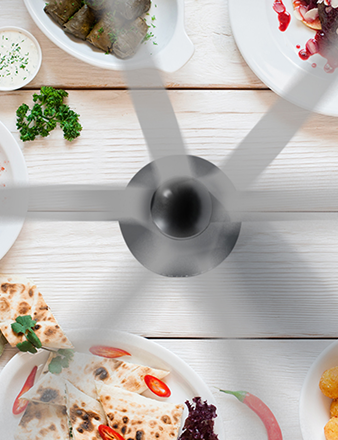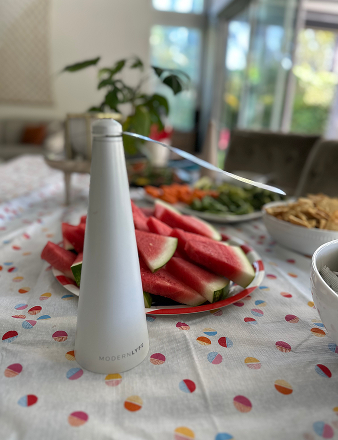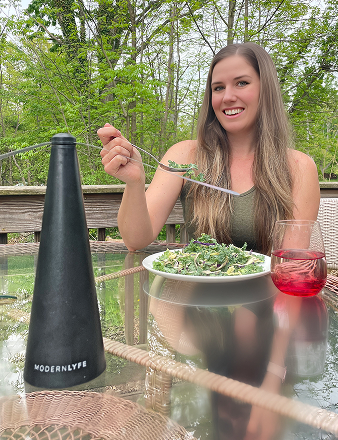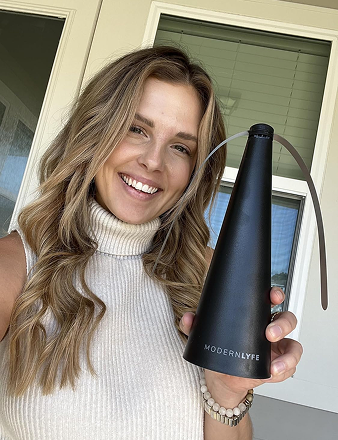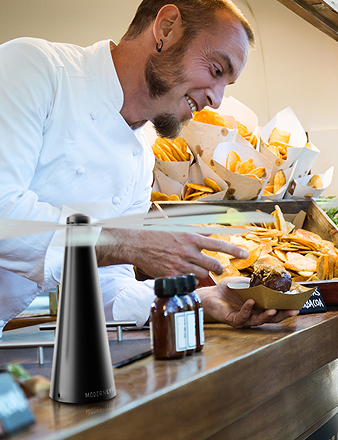An effective fruit fly catcher doesn't just trap pests—it uses their biology against them. Most models use a powerful lure, like the scent of fermented fruit or a specific UV light wavelength, to draw flies in and stop them for good.
Choosing the right trap depends on your space. You need to balance the severity of your fruit fly problem with safety for pets and children, and consider how the trap will look in your home or business.
Understanding Your Fruit fly Catcher Options
Picking the right fruit fly catcher is a strategic move. You need to match the trap's design to your specific problem. The heavy-duty trap required for a busy restaurant kitchen is completely different from the discreet one you'd want in your living room.
First, know your enemy. Fruit flies are notorious for their rapid breeding. A few can become a full-blown infestation almost overnight due to their short lifecycle. This is why just swatting them away never works.
This image shows just how fast they multiply.

A fruit fly can go from egg to adult in about 8 days, and a single female can lay up to 500 eggs. You need a solution that works faster than they can reproduce.
Key Factors in Your Decision
To get the right tool for the job, consider these key points:
- Environment: Where is the problem? A commercial kitchen with constant traffic needs a durable, high-capacity model. For your home, you'll likely want a silent and unobtrusive option.
- Safety: This is critical if you have pets or children. Non-toxic options like UV light traps or sticky traps are safer than liquid baits that can be spilled.
- Maintenance: How much upkeep are you willing to perform? Some traps need their bait refreshed every few days. Others, like the Modern Lyfe catcher, offer a "set it and forget it" solution with long-lasting adhesive pads.
For example, a coffee shop owner might choose a powerful UV trap mounted high on a wall in the prep area, away from customers. A homeowner protecting their indoor herb garden might prefer a small, decorative liquid trap that blends in with the pots.
The most effective fruit fly catcher is the one best suited to your specific environment and needs—from the size of the infestation to your safety concerns.
Fruit Fly Catcher Type Comparison
This comparison of common fruit fly catcher types can help you decide. Each has strengths and weaknesses depending on the situation.
| Trap Type | Best For | Pros | Cons |
|---|---|---|---|
| Liquid Bait Traps | Kitchens, pantries, areas with food sources | Inexpensive, often DIY-friendly, effective lure | Can be messy, requires frequent refilling, potential for spills |
| Sticky Traps | Greenhouses, indoor plants, near windows | Non-toxic, simple to use, visually confirms catches | Can look unsightly, may catch other insects, less effective in large areas |
| UV Light Traps | Larger spaces, commercial settings, homes | Highly effective, covers a wide area, low maintenance | Higher initial cost, requires electricity, bulb needs eventual replacement |
| Decorative Traps | Living areas, offices, visible spaces | Aesthetically pleasing, discreet | Often have smaller capacity, may be less potent than other types |
Ultimately, the goal is to find a trap that not only works but also fits seamlessly into your daily life.
Matching Trap Type to Your Needs
Different traps target flies in different ways. A classic liquid bait trap uses an attractant—like apple cider vinegar—to lure flies into a container they can't escape. Sticky traps are simpler, relying on a non-toxic adhesive surface to catch any fly that lands.
Modern solutions like UV light traps use specific light wavelengths to attract flies before capturing them on a hidden sticky pad. The right choice often comes down to figuring out how to keep flies away from your food in your specific environment.
Market data shows that most people seek affordable solutions. In 2025, the under $30 price range is expected to dominate the fly trap market with a 69.85% share, indicating that cost is a major factor for most buyers. Of course, mid-range ($30–$60) and premium (over $60) models exist for those who need higher performance or greater durability for commercial use.
Finding the Best Placement for Your Trap

Even the best fruit fly catcher will fail if it's placed in the wrong spot. The secret is to think like a fruit fly and put the trap where they congregate.
These pests are driven by scent, specifically the smell of fermentation. They swarm around "hotspots" in your home or business. Your mission is to identify these areas and make your trap the most appealing thing around.
A well-placed catcher does more than just trap flies; it actively pulls them away from potential breeding grounds. It’s about breaking their lifecycle and stopping a small problem from becoming a major infestation.
Identify Fruit Fly Hotspots
Before you set up your trap, do some quick detective work. Where do you see the most flies? They’ll lead you right to their favorite locations.
You'll almost always find them in these areas:
- Near Fruit Bowls: This is an obvious one. Set the trap within a few feet of your fruit, but not directly on top of it. The goal is for the trap's lure to be more powerful than the scent of the ripening fruit.
- Beside the Sink: Drains and garbage disposals are prime breeding grounds, filled with trapped food particles. A catcher placed on the counter next to the sink is a smart move.
- Close to Trash and Compost Bins: Any bin with organic waste is a fruit fly magnet. Placing a trap nearby will intercept them as they investigate the source.
Don't forget less obvious spots. A home bar with open wine bottles or a pantry where you store potatoes can also become hotspots.
Key takeaway: Set up a defensive perimeter. By placing traps at their main entry and breeding points, you catch flies before they have a chance to multiply and take over your space.
Placement Strategies for Different Settings
The right placement depends on the environment. A busy restaurant faces different challenges than a quiet home kitchen. Here's how to approach common scenarios.
For a Home Kitchen
In most homes, the problem areas are concentrated. The best approach is to place one trap near the main sink and another close to your fruit bowl. If you have a compost pail on the counter, that's your third key location. This creates a triangle of defense covering the most likely trouble spots.
A quick tip: Don't put the trap in a sunny window. The heat can interfere with the attractant and reduce its effectiveness.
For a Commercial Bar or Restaurant
In a high-traffic business, you need to be more aggressive. The goal is to stop flies before customers see them.
- Place traps behind the bar, especially near soda guns and floor drains.
- Put units in kitchen prep areas, focusing on washing stations.
- Don't forget the server station where dirty glasses and plates accumulate.
By targeting these back-of-house hotspots, you keep the front of your establishment clean and professional. It’s about making the trap work smarter, not harder.
Setting Up and Maintaining Your Catcher

You've picked the perfect spot—now it's time to activate your Modern Lyfe fruit fly catcher. The setup is designed to be quick and simple so you can start tackling your pest problem immediately.
Just unbox it, plug it in, peel the paper from the sticky card, and slide the card into place. That's it. It's a true "set it and forget it" device, allowing you to get back to your day without managing another complicated gadget.
Activating It and Knowing It's Working
The moment you plug in the catcher, its UV light turns on, acting as a magnet for any fruit flies in the vicinity. There are no buttons or timers to manage; it's built to run silently and continuously as soon as it receives power.
A steady blue glow indicates the trap is powered on and working. It's that straightforward, meaning anyone can operate it without needing an instruction manual.
A common mistake is expecting instant results. While the trap is effective, it can take a few hours for flies to find the light and for you to see a noticeable drop in their numbers. Give it a little time to work.
A Quick and Easy Maintenance Routine
Keeping your fruit fly catcher in top condition is the key to long-term success. The goal is to maintain its effectiveness without turning upkeep into a major chore. A simple, consistent schedule is all it takes.
Here is a practical routine:
- Weekly Check: Once a week, glance at the sticky card. This shows you the severity of your fly problem and confirms the trap is working.
- Swap the Card: Plan to replace the adhesive card every 2-3 weeks. If you notice it's covered in flies sooner, swap it out. A full card is a good sign, but it can't catch any more pests.
- Quick Wipe-Down: When you change the card, wipe the exterior of the catcher with a dry cloth. This prevents dust buildup and keeps it looking clean.
This minimal effort keeps your device hygienic and highly effective.
Disposal and Heavy Infestations
Disposing of used cards is a clean, no-touch process. The flies are stuck firmly to the adhesive, so you can just slide the card out and drop it directly into the trash. No mess, no fuss.
If you're facing a serious swarm, you might see the card fill up in less than a week. In that case, check it every couple of days. Changing the card more frequently at the beginning will help you get the situation under control much faster by breaking the breeding cycle.
Once you notice the numbers decreasing, you can return to your regular replacement schedule.
Preventing Fruit Flies Before They Start
A good fruit fly catcher is your best defense once pests arrive, but the real victory is making your home an unattractive place for them in the first place. This is about creating an environment where fruit flies can't thrive. It’s not about endless cleaning, but rather a few smart habits that break their life cycle before it begins.
Think of it as locking the door before they knock. Small changes to how you handle produce and clean your drains can turn your home from a fruit fly paradise into a no-fly zone.
Make Your Kitchen Less Inviting
The most reliable prevention tactic is to cut off their food supply and eliminate breeding spots. Fruit flies are drawn to anything fermenting, so your main job is to keep that away from them.
Here are a few practical habits that have the biggest impact:
- Monitor the Fruit Bowl: Check your fruit daily. If a banana has too many brown spots or an apple is getting soft, eat it, refrigerate it, or compost it immediately. One piece of overripe fruit can start an infestation.
- Wipe Up Spills Instantly: A splash of juice, wine, or soda is an open invitation. Cleaning it up right away removes a powerful attractant.
- Keep Drains Clear: Pouring boiling water down the kitchen sink once a week is a game-changer. It flushes out gunk and potential eggs. For a tougher job, a combination of baking soda and vinegar still works wonders.
This proactive approach is the core of integrated pest management (IPM). By making your space less friendly to flies, you'll rely on your trap less.
The most powerful shift is moving from reacting to flies to proactively preventing them. This addresses the root of the problem for a lasting, fly-free home.
Securing Common Breeding Grounds
Beyond the fruit bowl, fruit flies have a few other favorite, often overlooked, places to breed. Keeping these spots on your radar is crucial to preventing a population explosion.
Pay special attention to these areas:
- Trash & Compost Bins: Always use bins with tight-fitting lids. Take out bags with food scraps daily. Rinse recyclables like wine bottles or soda cans before binning them.
- Sponges & Mops: A damp mop or an old sponge can become a breeding ground. Squeeze them out completely and let them air dry where they won't stay damp.
- Sticky Surfaces: Wipe down counters, pantry shelves, and the outside of condiment jars. A small dribble of honey or soy sauce you missed could be the source of the problem.
Taking these steps helps you gain the upper hand. For a deeper dive into keeping your home pest-free, see our guide on how to control fruit flies.
It’s no surprise that consumers are shifting toward non-chemical solutions. The global fly trap market, which includes devices like the fruit fly catcher, was valued at around USD 415 million in 2025 and is projected to reach USD 623 million by 2030. This highlights a collective demand for safe and effective pest management at home. You can explore global fly trap market trends on mordorintelligence.com for more details.
Troubleshooting Common Fruit Fly Trap Issues

If you've set up your fruit fly catcher and it isn't performing as expected, don't worry. Most of the time, a few simple tweaks are all it takes to solve the problem. Let's review the most common issues and their solutions.
The top issue is a trap that isn't catching many flies. Before blaming the device, look around the room. Often, the trap is simply being out-competed by a more tempting target nearby.
My Trap Isn't Catching Flies
If fruit flies seem to be ignoring your catcher, it's time to find the competing scents. That forgotten banana on the counter or the last sip of juice in a cup can easily draw attention away from your trap.
Here’s a quick checklist to follow:
- Clear the Competition: Remove any overripe fruit, open drinks, or sticky spills from your countertops. For the trap to be effective, it needs to be the most appealing scent source in the area.
- Rethink the Location: The trap should be placed where the flies are—near fruit bowls, sinks, or trash cans. Avoid placing it directly next to a bright window, as sunlight can compete with the UV light attractant.
- Be Patient: The trap needs time to work. Give it a full 24 hours to perform before judging its effectiveness.
When a trap isn't catching flies, the problem is almost always environmental. Eliminating competing scents and ensuring proper placement will solve the issue 90% of the time.
The Fruit Fly Problem Seems to Be Getting Worse
It's frustrating to install a fruit fly trap only to see more flies. If this happens, it’s a strong indicator of a hidden breeding ground that a single trap can't handle.
Remember, a single female fruit fly can lay up to 500 eggs, so a small, hidden source can quickly lead to a massive infestation.
Hunt for these less obvious culprits:
- Check for a damp sponge or mop head stored under the sink.
- Clean the buildup from deep inside your garbage disposal.
- Look for a spoiled potato or onion at the back of the pantry.
Once you find and eliminate the source, your catcher can finally do its job and remove the remaining population. This is about playing offense, not just defense. For more ideas, read our guide on how to repel fruit flies. Pairing trapping with prevention creates a much stronger, more lasting defense.
The Bigger Picture: Fruit Fly Control on a Global Scale
The fruit fly in your kitchen is part of a much larger story. While it's a personal annoyance for you, these tiny insects are a massive threat to farmers and the global food supply. The battle in your home is a small-scale version of a war being waged in orchards worldwide.
These pests are destructive. Invasive species like the Mediterranean and Asian fruit flies can wipe out over 50% of a fruit crop, threatening food security and farmers' livelihoods. This drives the constant search for better control methods—from large-scale trapping systems to the simple, effective catcher on your counter.
A Multi-Billion Dollar Battle
The global effort to manage fruit flies has created a significant industry. In 2023, the market for fruit fly control was valued at around USD 3.07 billion and is expected to grow to USD 4.1 billion by 2032—a clear sign of how critical this fight is. The rising demand for fresh, unblemished fruit fuels the need to prevent these devastating losses. You can find more details on the economic impact of fruit fly control on wiseguyreports.com.
This economic pressure fuels innovation. Scientists are developing everything from sophisticated pheromone lures that disrupt mating cycles to "smart" farming tech that monitors pest populations in real-time. All of these advanced solutions share the same goal as your home device: stop infestations effectively and safely.
When you choose a modern, non-toxic fruit fly catcher, you're participating in a global shift toward smarter, more sustainable pest control. You're not just protecting your kitchen; you're part of a movement that protects our food supply without relying on harsh chemicals.
The design of your Modern Lyfe catcher is a direct result of this larger movement. By opting for a well-designed, chemical-free solution, you’re supporting a trend that prioritizes sustainability, food safety, and intelligent pest management.
Got Questions? We've Got Answers
Even with the best trap, you might have a few questions. Here are the answers to some of the most common queries we receive.
How Quickly Will I See Results?
This is the most common question. You plug the trap in and want the flies gone immediately. The Modern Lyfe catcher starts working instantly.
However, it can take a few hours for fruit flies to notice the UV light and investigate. You will see the most significant results within the first 24 hours as the population is drawn in and trapped.
Is It Safe to Use Around My Family and Pets?
Absolutely. The Modern Lyfe catcher is designed with safety as a top priority. You don't want to bring anything toxic into your home.
It relies on two simple, non-toxic elements:
- A low-intensity UV light to attract flies.
- A sticky glue card to trap them.
There are no chemicals, pesticides, or liquid baits to worry about. You can plug it in anywhere—kitchen, nursery, or living room—without concern.
Can I Use This Trap Outdoors?
While it’s tempting to use this trap outside, especially during barbecue season, it is designed specifically for indoor use.
Outdoors, sunlight, porch lights, and other distractions compete with the trap's UV light, making it far less effective. It is also not built to withstand rain or humidity. For the best results, keep it indoors.
Wait, Are These Fruit Flies or Gnats?
It's easy to confuse them, but knowing the difference is key. Fruit flies are typically tan-colored, rounder, and have red eyes. You'll find them near fruit or wine. Gnats are usually darker, more slender, and congregate near houseplants, sinks, and drains due to their attraction to moisture.
Our catcher is designed for fruit flies. If you have a gnat problem, you'll need a different strategy focused on drying out soil and clearing drains.
Will This Get Rid of Fruit Flies for Good?
A trap is a powerful tool for breaking the breeding cycle by catching adults before they can lay more eggs. But a permanent solution requires pairing the trap with prevention.
Think of the trap as your first line of defense and your habits as the long-term solution. By cleaning spills, storing ripe produce in the fridge, and taking out the trash regularly, you eliminate what attracted the flies in the first place.
Ready to stop your fruit fly problem with a safe, silent, and stylish solution? Check out the MODERN LYFE catcher and reclaim your space. Shop now at modernlyfe.com.

